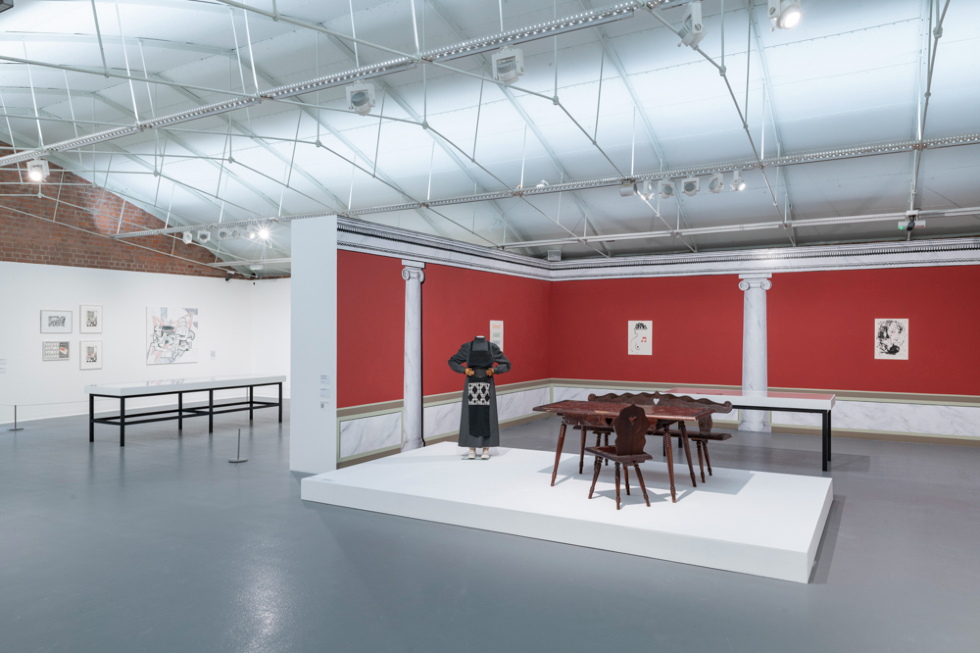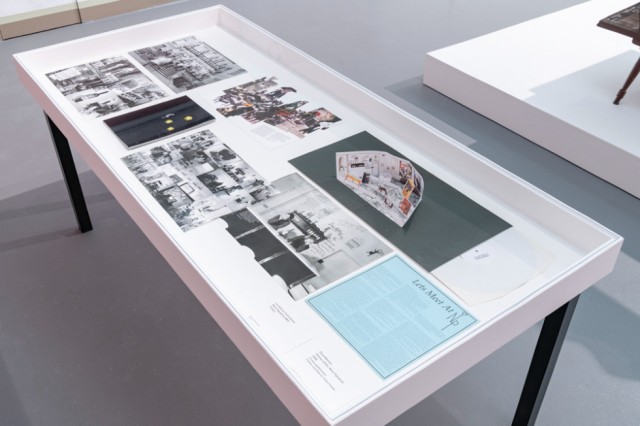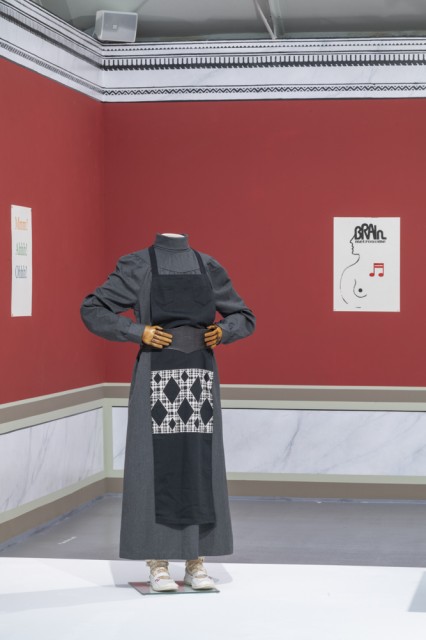A Modern Total Artwork – The Case For Lucy McKenzie’s Nova Popularna

“Can an artist ever fully embody their art?” Maja Lorkowska makes the case for Nova Popularna, a co-created artist salon doubling as bar and hang-out, currently on display as part of Tate Liverpool’s Lucy McKenzie retrospective…
The term ‘total work of art’, popularised by composer Richard Wagner, has since been tainted by fascist ideology associated with Wagner’s love of certain German traditions, and his search for aesthetic synthesis leaning towards totalitarianism. Yet the core idea hasn’t changed much since the mid-19th century: different art forms combined to create a single cohesive whole, perhaps most commonly exemplified in the harmony between architecture and interior design – such as the sharp edges of the Bauhaus, covered in primary colours both inside and out. In a contemporary art world where interdisciplinarity can be advantageous, and often assumed, such fusions seem natural.
But can an artist ever embody their art so fully – breathe it, live within its spaces, wear the clothes they’ve designed and sip the spirits they’ve brewed? Can the ‘total work of art’ – Gesamtkunstwerk – ever truly be achieved? Lucy McKenzie certainly came close to something that percolated through nearly every aspect of her life. In 2003, together with fellow artist Paulina Ołowska, McKenzie opened Nova Popularna – an ‘artist salon’ in Warsaw’s Foundation Gallery Foksal, for a month (the pair met in the Netherlands in 1988, and have remained friends and collaborators ever since). The gallery, which represents Ołowska, is a celebrated institution in Poland and beyond, associated with some of the biggest names in Polish art.
Nova Popularna (or New Popular, in English) was a café, illegal bar, concert venue and meeting place for Warsaw’s creatives familiar with the Foksal’s expanded operations; exhibitions, of course, but also related artist projects, including events, publications and concerts. Set within what would ordinarily be the gallery, Nova Popularna operated from the 2nd to the 29th of May, with every aspect designed and created by the artists: from murals and the posters pinned on walls; the specially conceived soundtrack; to the choice of furniture and apron patterns for the staff. The spirits they sold were home-made and the only branded beer and cigarettes available were chosen for “their aesthetic girlishness” – the cigarette box decorated with colourful flourishes reminiscent of a sunset at sea; beer bottles adorned with an image of couples dancing the traditional ‘Krakowiak’ dressed in folk clothes. Colourful and pretty, no smoking cowboys in sight.

At Tate Liverpool, this section of McKenzie’s retrospective is prominent (sadly sans alcoholic beverages), with a cosy three-wall, deep red mural enveloping the viewer. For me, the most significant aspects of it were Ołowska as co-creator and Poland as a setting because, I myself, am Polish. Seeing an article written in my mother tongue in one of the vitrines displaying archival material immediately made me less suspicious of the tricksy work. There is something about encountering Polish art (or reading about art in Polish) that removes the disconnect between myself, the art, and its theory. Perhaps I was just a little nostalgic, and it felt satisfying to know that McKenzie really engaged with the culture of the place and for a short while became embedded in its social fabric.
Like her partner in crime, Paulina Ołowska’s own oeuvre also sometimes owes a debt to that which came before. She has previously recreated and manipulated the work of artists like Zofia Stryjeńska or Alina Szapocznikow to exhibit them on a monumental scale. Both women were very well-known artists in the early to mid-20th century, but Ołowska’s intervention – no mere pastiche – sought to save them from being overlooked by subsequent generations. Her approach is more one of homage, then, as opposed to McKenzie’s critical raspberry-blowing “I can do it just as well as you did 200 years ago!”.
And Nova Popularna seems to me to share DNA with other examples of art projects and places that came close to the Gesamtkunstwerk ideal: Cricot theatre led by Józef Jarema, and the more prolific Cricot 2 led by the now world-famous Tadeusz Kantor – both of which were avant-garde, experimental theatre projects that gathered artists from an array of disciplines, closer to living assemblages than traditional performances. Perhaps more akin to Nova Popularna, however, is Piwnica pod Baranami, a basement bar in the heart of Kraków, that exists to this day, known as the place where creative free spirits and local intelligentsia exchanged ideas, watered by wine and surrounded by the ghosts of those that came before. Yet, none of these examples could truly be called a ‘total artwork’, they are amalgamations of art and life in equal proportions, taking place in their respective contexts; one was theatre, the other is a bar. Because the context of Nova Popularna was a place whose primary purpose was to exhibit art, it remained an artwork while simultaneously being a site of work and play.
There is an alignment between McKenzie and Ołowska in the desire to reconstruct, employ and address long-gone aesthetics, and bring back the atmosphere of a particular time by adopting other artists’ methods. In this instance, this way of inhabiting other artist’s styles was truly made a reality, with works like Edouard Manet’s Un bar aux Folies Bergère and others used as direct inspiration for the interior design of the salon. About using Manet’s barmaid as inspiration, McKenzie has said: “we wanted to give [women] a life away from the male gaze, make an environment for them and also become them.” Here, the totality of the artwork comes into full focus, with the artists putting themselves in the shoes of the barmaid, rather than just playing out the role of the woman from the painting.

After Nova Popularna closed, the artists created collages and other works to commemorate the project because, after all, it was an artwork, facilitated by a gallery. Yet, the interactions with people and the difficulties encountered while running the salon were what activated the project, kept it close to the ground before it had a chance to inflate like the egos of overly ambitious curators, and float up and away on the winds of privilege. It simply couldn’t be a staged performance or planned engagement, because life would get in the way and people, particularly when they’re drunk, are too real for that.
Drinking moonshine inside a living, breathing Manet painting, is surely as close as you can get to existing within a total artwork, if only for a limited period of time. Of course, you could spend a lifetime devoted to constructing the exact living space, curating every object in it, every song and every carefully arranged meal, while recording and marketing it to the world as art. (I may have just described 80% of social media but this would be a discussion for another time.) If, however, you want to hang out with people in an iconic art setting while having a drink, Nova Popularna was a pretty good attempt. The interiors, clothes, people, what they consumed and talked about all merged into one – not a performance of life, but life itself. Perhaps the main argument for Nova Popularna being an example of a total artwork is that in some ways, it’s the opposite of ‘relational aesthetics’, an artistic mode in which social situations become the artwork, and the artists are conduits for the experience they are facilitating.
For McKenzie and Ołowska, there was a strong focus on the visual aesthetics of the place yet no formal ‘engagement’ element – people came and went, they had a chat over a drink and sometimes came back again. It did not squeeze itself into the existing infrastructure of a particular area or group of people. It simply became an option to take or leave like any other exhibition (or bar), and relied on word of mouth, particularly among artists. McKenzie has said that “the freedom of a bar is that it’s just a place you come to have a drink, there’s no real focus” and that the “places [she] likes to socialise in mostly don’t exist, so [they] had to make it.”
Perhaps I am biased, and give this project more credit than I would afford any Western undertaking under the guise of experience as art, or another trend with similar concerns. But just think of tasting that home-made vodka in an artist-led bar and tell me you wouldn’t want to be part of McKenzie and Ołowska’s version of the contemporary total artwork or, indeed, a place to socialise that wouldn’t otherwise have existed.
Maja Lorkowska
This new text has been commissioned in association with Tate Liverpool and is part of a creative-critical series published exclusively by The Double Negative. Writers were given free rein to respond to any work – or works – in the exhibition, and in any style, tone or format that they wished to use.
Further Reading: “A statement but also a question.” Lucy McKenzie – Reviewed
Lucy McKenzie continues at Tate Liverpool until 13 March 2022
Images: Installation view of Lucy McKenzie at Tate Liverpool, 19 October 2021 – 13 March 2022 © Tate (Sam Day and Rod Tidnam)





